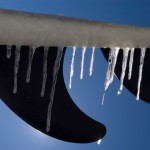Sports
Cold Play
Saturday, Jan 05, 2013 1:53 pm
Diehard Maine winter surfers don’t let the chill ice their fun.
By Clint Willis
 It is December. The water temperature at Higgins Beach in Scarborough, Maine, is 35 degrees, the air temperature is 28 degrees, the wind offshore registers eight miles per hour, and there is a decent swell coming from the southeast. I know all this because I just checked a surfing website. It is also sleeting. I know this because I just looked out the window.
It is December. The water temperature at Higgins Beach in Scarborough, Maine, is 35 degrees, the air temperature is 28 degrees, the wind offshore registers eight miles per hour, and there is a decent swell coming from the southeast. I know all this because I just checked a surfing website. It is also sleeting. I know this because I just looked out the window.
A few years earlier, a day like this might have seen me loading up my gear to go ice climbing in New Hampshire. But I took a surfing lesson three years ago. I’ve been surfing about 400 times, maybe more. The figure would be higher, but I came down with pneumonia after my first winter surfing session (I went into the water with bronchitis) and missed a couple of months.
All that surfing doesn’t leave much time for climbing and, in any case, the mountains are two hours away. The waves are right down the road. I struggle into my winter wetsuit, grab my neoprene booties and mittens, and wrestle my long board (a 9’0†beauty made by J.C. of Hawaii) down from the rack in the garage.
At the beach, I sit in my car and watch the other surfers for a minute. They sit upright on their boards just beyond the breakers, facing the incoming swell. Sheathed and hooded in their black wetsuits, they suggest alien creatures at some mysterious and pointless task. I register my own need to join them—it feels good to want something that much. I wrestle my board off the roof and trot down the beach to the sea.
The first steps into the water are easy enough. I wade into deeper water, until finally a wave breaks over my head. The water on my face is very cold. Some water leaks into the wetsuit, but (believe it or not) it isn’t nearly as bad as the shock of wading into this water in board shorts in July. Still, the sense that I am somewhere I don’t belong is strong, and a little intoxicating.
I’m on my board now, paddling out through the surf; each wave pummels me and my board in a series of trials by water that gets old fast. But in maybe five minutes I’m outside—past the breakers—and the world is suddenly quiet. I sit up on my board, glancing back at shore some hundreds of yards in the distance, dim and gray through the sleet. The sky reaches down to the surface of the ocean and encompasses me and my fellow surfers in this shifting winter light.
The first wave of a set approaches. I turn and lie flat on my board and paddle hard. The wave lifts the back of my board; I press my palms down, lifting my head and chest (yogis call it the cobra pose), then hop to my feet and lean into the wave; this initiates a turn across the face just ahead of the curl. The wind blows spray and sleet into my face but my sight clears and I see the wave form ahead, a carpet of energy unfurling just where I need it to be.
I lose focus and my speed dies and I’ve blown it; the wave jacks up under my board and I am hurled by the sea into the sea. Even this is wonderful in its way: The wave explodes on top of me and I tumble submerged in the cold dark wet—I am flotsam. I break the surface and breathe and squint and feel the ice cream headache. My board floats nearby; I grab the leash that links it to my ankle and pull it to me and swing aboard (strangely, the motion brings to mind mounting a horse without saddle stirrups) and paddle for the outside.
No one knows how many folks surf in Maine in the winter, but the number has grown in recent years. The best-known spots, like Higgins Beach and Scarborough Beach, both just south of Portland, can get crowded when a swell rolls in. And why not? The surfing is better and more consistent in the fall and winter, and crowds (despite the recent surge in popularity) are smaller than in summer—which means less competition for waves. Have a look:
It’s also really, really pretty out there. Duncan Stout, 64, a partner in a Portland advertising agency started surfing five or six years back. “Sometimes when it’s foggy or snowing the light gets really flat and the horizon seems to sink, so the waves look like they’re coming at you uphill. And riding a wave when it’s snowing—it’s so beautiful you can’t quite believe it.â€
Janice Parente, 45, lives in Scarborough; she is chairperson of the Northern New England division of Surf Rider (www.surfrider.org), a non-profit group that works to preserve coastal waters and protect beach access. Beachfront property owners don’t always like sharing their water views—and they can afford expensive lawyers. But the views from a surfboard in winter are too good to give up without a fight. “I was surfing a week ago at sunset,†says Parente. “These gorgeous head-high waves were rolling through. To our left over Harmon’s Island was this huge rainbow; to our right was this beautiful sunset. No one was going for the waves; we were all mesmerized by the sky.â€
Is winter surfing dangerous? It can be. David Turin, 53, who runs a couple of restaurants in the Portland area, as well as the local surf camp (www.surfcampme.com) where I got my start, is not a timid dude. He’s surfed 15-foot faces off the (sharky) coast of South Africa, and has been an open-water swimmer for years, competing in the 2.4 mile Peaks to Portland race eight times. But Turin has a rule: “I don’t go out if the air temperature and the water temperature don’t add up to at least 60 degrees. Surfing can make you feel invincible. But one really cold day I got into a rip current and ended up way out there. I had to fight very hard to get back in, and the cold made it much more difficult. I realized I could get swept out to sea and that would be that.â€
Ben Keller, 42, also of Scarborough, whose 2003 film Ishmael documented winter surfing in New England, puts it this way: “If you don’t know your limits, you learn them pretty quickly.â€
One thing you also learn: Some surfers don’t like to share their breaks any more than beachfront property owners like to share their beaches. “People would kill me if I told you about some spots I know in Northern Maine,†says Keller.
True, Surfmaps.com will sell you a map that shows 14 spots in Maine (there are many more), but it includes entries like this one: “Fast waves here if you can find it…†Many breaks fire only occasionally; an Atlantic swell must come from just the right direction to skirt the points, peninsulas and islands that guard much of the shoreline. And some spots are shallow and rocky, or plagued by dangerous currents. In short: spooky.
But spooky can be kind of nice. And when the wind blows offshore and the waves are chest-high, when snowflakes drift in the fading light and most Mainers are inside drinking tea, a surfer can paddle out and find a piece of the world that nobody owns.
Clint Willis has published more than forty books, including award-winning anthologies on topics such as adventure, politics, religion, and war. His writing has appeared in hundreds of publications, including Men’s Journal, Money, Outside and the New






Leave a Reply